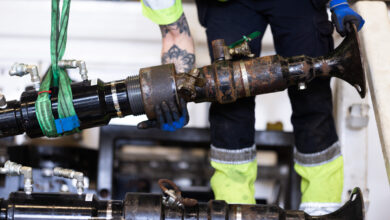Wood Mackenzie: Deferred projects hit deepwater sector hardest
An updated Wood Mackenzie analysis concludes that in the last six months of 2015, an additional 22 major projects and 7 billion barrels of oil equivalent (BOE) of commercial reserves have been deferred. That came on top of the 46 developments and 20 billion BOE of reserves identified previously. Deepwater projects have been hit hardest, accounting for more than half of the total, as companies are forced to rework projects with high breakevens, large capital requirements and high costs.
“The impact of lower oil prices on company plans has been brutal,” Angus Rodger, Principal Analyst – Upstream Research for Wood Mackenzie, explained. “What began in late 2014 as a haircut to discretionary spend on exploration and pre-development projects has become a full surgical operation to cut out all non-essential operational and capital expenditure. Tumbling prices and reduced budgets have forced companies to review and delay final investment decisions (FID) on planned projects, to reconsider the most cost-effective path to commerciality and free up the capital just to survive at low prices.”
Wood Mackenzie’s report, “Pre-FID Project Deferral Update: Deepwater Hit Hardest,” has identified 68 large projects globally that have had FID delayed due to the fall in oil prices from 2014 to the end of 2015. The list has grown by more than a third in the last six months, as more and more projects are deferred through the down-cycle. Mr Rodger added: “For all 68 projects, there are multiple elements contributing to delay. Price is rarely the only factor slowing down FID, but it has exerted the strongest influence.”
Key takeaways:
- $380 billion of total project CAPEX deferred (real terms), from the 68 projects;
- Of the $380 billion CAPEX, delayed spend from the 68 projects from 2016 to 2020 totaled $170 billion;
- Deepwater is hit the hardest, accounting for more than half of new project deferrals up from 17 to 29; 62% of total reserves; and 56% of total CAPEX;
- 2.9 million bbl/day of liquids production deferred to early next decade, up from 2 million bbl/day;
- Oil most impacted: deferred liquid volumes up 44%, versus 24% for gas; and
- Average breakeven of delayed greenfield projects is $62/BOE.
“One reason we are seeing a growing list of delayed projects is cost deflation – or, to be more accurate, the need for costs to fall more to stimulate investment,” Mr Rodger added. And the analysis shows that this is where deepwater has made the least gains: “The biggest jump in pre-FID delayed projects over the last six months was in the deepwater, rising from 17 to 29, where costs have only fallen by around 10% despite the global crash in rig dayrates. Despite the size of these fields, the combination of insufficient cost deflation and significant upfront capital spend has discouraged companies from greenfield investment in the sector.”
Tom Ellacott, Vice President of Corporate Analysis for Wood Mackenzie, points out that since Wood Mackenzie last ran this analysis, a key change for companies is stricter investment criteria. “Companies are having to adjust investment strategies to the risk of sustained low prices, and this means tougher screening criteria for pre-FID projects. We believe that most companies will now be looking for these developments to hit economic hurdle rates at around $60/bbl. Tougher capital allocation criteria will give companies the framework to make difficult decisions about restructuring portfolios, optimizing pre-FID projects and capturing the full benefits of cost deflation. If a sector or country cannot meet new investment thresholds and compete for capital, operators are now more likely to choose divestment over warehousing a stranded resource.”
The production impact of these deferments is material in a global context: “By 2021, deferred volumes will reach 1.5 million bbl/day, rising sharply to 2.9 million bbl/day by 2025,” Mr Rodger qualified. The report’s findings conclude that FIDs on many of these projects have been pushed to 2017 or beyond, with first production currently targeted between 2020 and 2023. But against a backdrop of overwhelming corporate pressure to free up capital and reduce future spend – to the detriment of production growth – there is considerable scope for this wall of output to get pushed back further if prices do not recover and/or costs do not fall enough.
The global analysis also reveals which countries are worst affected. “The countries with the largest inventory of delayed oil projects are Canada, Angola, Kazakhstan, Nigeria, Norway and the US, which hold nearly 90% of all deferred liquids reserves. This includes oil sands, onshore, shallow-water and deepwater assets in both greenfield and incremental developments,” Mr Rodger said. “Those with the largest gas reserves are Mozambique, Australia, Malaysia and Indonesia, which combined hold 85% of the total volume. The majority of this gas is found offshore, primarily in deepwater locations, and requires complex and expensive development solutions, including greenfield LNG and FLNG.”
Mr Ellacott concluded: “With oil prices recently falling to their lowest level since 2004, oil and gas companies will be forced to go into survival mode in 2016. Further project delays and cuts to discretionary investment are highly likely. That said, companies are being forced to reevaluate how they can profitably develop large, high-cost conventional resources at low prices. Not only are we seeing a genuine push toward standardization, but low prices will also promote a level of innovation so far only seen in US tight oil. The pace of CAPEX and OPEX deflation may, therefore, surprise on the upside in 2016. Finally, we expect oil prices to start recovering during the second half of the year, which should encourage first-movers to kickstart investment and lock in gains from cost deflation ahead of the herd.”




